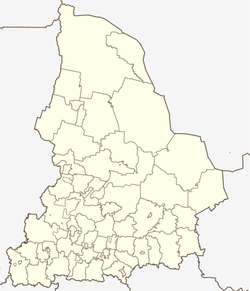Kushwa
| city
Kushwa
Кушва
|
||||||||||||||||||||||||||||||||||||||
|
||||||||||||||||||||||||||||||||||||||
|
||||||||||||||||||||||||||||||||||||||
| List of cities in Russia | ||||||||||||||||||||||||||||||||||||||
Kushwa ( Russian Кушва ) is a city in Sverdlovsk Oblast ( Russia ) with 30,167 inhabitants (as of October 14, 2010).
geography
The city is located on the eastern edge of the Urals , about 170 km north of the Oblast capital Yekaterinburg , in the headwaters of the Tura River . The climate is continental.
The city of Kuschwa is directly subordinate to the Oblast. The city is subject to 12 villages with a total of 12,424 inhabitants and the city of Verkhnyaya Tura (10,568 inhabitants), so that the total number of inhabitants in the administrative unit "City of Kuschwa" is 56,207 (2009 calculation).
Kushwa is located on the Perm - Yekaterinburg railway, opened in 1878 , the former Ural mining railway ( Уральская Горнозаводская железная дорога / Uralskaja Gornosavodskaja schelesnaja doroga). The line to Serow , which was opened in 1906, branches off here , the former Bogoslowsk Railway ( Богословская железная дорога / Bogoslowskaja schelesnaja doroga). The city's station is called Goroblagodatskaya .
history
In place of today's town, a mine, ironworks and settlement were built in 1735 on the basis of the mining of the important iron ore deposit Gora Blagodat east of the town. The term Gora Blagodat ( Гора Благодать , blessing - or Gnadenberg ) refers to the religious concept of benediction and grace , in connection with the name of the then ruling Russian Empress Anna Ivanovna (see. Anna Hebrew and Others for.. Grace ). The hut and place were named after the Kuschwa , a small right tributary of the Tura, Kuschwinski Sawod ( Кушвинский завод , komi- permyak kush for bare place , wa for river ).
In 1801 the place became the administrative center of the surrounding mining area ("mountain district"), but it was not granted town charter until 1925 despite its importance. 1926 renaming took place Kuschwinski Sawod in Kushva .
Population development
| year | Residents |
|---|---|
| 1897 | 8,900 |
| 1926 | 14,200 |
| 1939 | 24,851 |
| 1959 | 46,150 |
| 1970 | 43,840 |
| 1979 | 43,259 |
| 1989 | 43.096 |
| 2002 | 35,555 |
| 2010 | 30,167 |
Note: census data (1926 rounded)
Culture and sights
Industrial architecture from the 19th century has been preserved to a greater extent. The city has a local museum.
economy
Iron ore mining and processing on the Gora Blagodat still play a central role in the city's economic life. The iron and steel metallurgy of the Middle and Northern Urals is mainly supplied from this deposit with total ore reserves of several hundred million tons .
There is also mechanical engineering (including railway equipment), wood processing and building materials management (gravel).
Personalities
- Viktor Subkow (* 1941 near Kuschwa), Russian politician
- Irina Kemmsies (* 1996), German volleyball player
Individual evidence
- ↑ a b Itogi Vserossijskoj perepisi naselenija 2010 goda. Tom 1. Čislennostʹ i razmeščenie naselenija (Results of the All-Russian Census 2010. Volume 1. Number and distribution of the population). Tables 5 , pp. 12-209; 11 , pp. 312–979 (download from the website of the Federal Service for State Statistics of the Russian Federation)
Web links
- Unofficial Portal (Russian)
- Kuschwa on mojgorod.ru (Russian)




